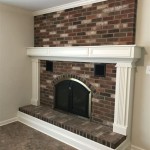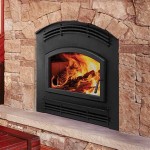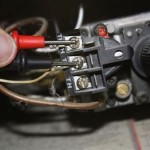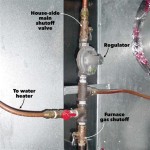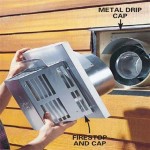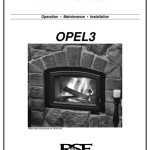Contemporary Fireplace Mantels with TV: A Convergence of Design and Technology
The modern living space is increasingly defined by its ability to seamlessly blend functionality with aesthetic appeal. One prominent example of this trend is the integration of a television above a fireplace mantel. This combination requires careful consideration of design principles to ensure both elements enhance, rather than detract from, the overall ambiance of the room. Contemporary fireplace mantels designed to accommodate televisions represent a sophisticated approach to home entertainment and interior design.
The historical role of the fireplace as the focal point of a room provided warmth and a gathering space. The mantel served as a decorative shelf for displaying treasured objects. Today, while fireplaces still offer a visual appeal and, in some cases, supplemental heat, the television has become a competing focal point. Integrating these two elements poses a design challenge that, when addressed thoughtfully, can create a harmonious and functional living space.
Key Considerations for Integrating a TV Above a Fireplace Mantel
Successfully merging a TV and fireplace mantel requires careful attention to several key factors, including mantel height, heat dissipation, and viewing angles. Neglecting these aspects can lead to discomfort, technical issues, and an aesthetically unbalanced room.
Mantel Height and Viewing Angle: The height of the mantel is a crucial determinant of the viewing comfort. A television mounted too high can lead to neck strain and an uncomfortable viewing experience. The ideal viewing height places the center of the screen at or slightly below eye level when seated. This necessitates careful calculation based on the height of the seating and the dimensions of the television. Lower mantels may be required to achieve this optimal viewing angle, potentially impacting the overall design aesthetic. Conversely, a mantel that is too low may impede the visual appeal of the fireplace itself.
Heat Dissipation and Protection: The heat generated by a fireplace can damage electronic components of a television. Adequate heat dissipation is essential to prevent overheating and potential malfunction. The mantel serves as a protective barrier, deflecting rising heat away from the television. The depth and material of the mantel are critical factors in its ability to effectively dissipate heat. Non-combustible materials such as stone, concrete, or metal are preferable for mantels above gas or electric fireplaces. For wood-burning fireplaces, a deeper mantel or additional heat shielding may be necessary. Furthermore, ensuring proper ventilation behind the television is crucial to prevent heat buildup. This can be achieved through strategically placed vents or a recessed mount that allows for airflow.
Aesthetic Harmony and Design Consistency: Integrating a TV above a fireplace mantel should be consistent with the overall design style of the room. The mantel should complement both the fireplace and the television, creating a cohesive and visually appealing composition. The size of the television should be proportional to the size of the fireplace and mantel. A large television above a small fireplace can appear disproportionate and overwhelming, while a small television above a large fireplace can seem insignificant. The style of the mantel should also align with the architectural style of the room. A modern, minimalist mantel is well-suited for contemporary spaces, while a more ornate mantel may be appropriate for traditional settings. Cable management is another important aesthetic consideration. Concealing cables behind the wall or within the mantel itself creates a cleaner and more polished look.
Material Choices for Contemporary Fireplace Mantels with TV
The selection of materials for a contemporary fireplace mantel plays a significant role in both its aesthetic appeal and its functional performance. Various materials offer different advantages in terms of heat resistance, durability, and visual characteristics. Common choices include wood, stone, concrete, and metal, each contributing a unique feel to the overall design.
Wood: Wood is a classic and versatile material for fireplace mantels, offering warmth and natural beauty. However, wood is combustible and susceptible to heat damage, making it less suitable for use above wood-burning fireplaces. When used with gas or electric fireplaces, careful attention must be paid to heat shielding and ventilation. Engineered wood products, such as MDF (Medium-Density Fiberboard), can provide a more consistent and stable surface for paint or veneer finishes. Solid wood mantels can offer a more substantial and traditional look, but they require proper sealing and maintenance to prevent warping or cracking. The choice of wood species can also significantly impact the aesthetic. Dark woods, such as walnut or mahogany, evoke a sense of formality and sophistication, while lighter woods, such as maple or birch, create a more casual and contemporary feel.
Stone: Stone is a durable and heat-resistant material that is well-suited for fireplace mantels, especially those above wood-burning fireplaces. Natural stone, such as marble, granite, or limestone, offers a timeless elegance and a wide range of colors and textures. Each piece of natural stone is unique, adding character and visual interest to the mantel. However, natural stone can be expensive and require professional installation. Manufactured stone veneers offer a more affordable and lightweight alternative, providing the look and feel of natural stone at a lower cost. Stone mantels can be combined with other materials, such as wood or metal, to create a layered and visually dynamic design.
Concrete: Concrete is a modern and industrial material that is gaining popularity for fireplace mantels. Concrete mantels can be cast in a variety of shapes and sizes, offering a customizable and contemporary look. Concrete is also highly durable and heat-resistant, making it a practical choice for fireplaces. The surface of a concrete mantel can be smooth or textured, and it can be stained or polished to achieve different finishes. Concrete mantels often have a minimalist design, emphasizing clean lines and simple forms. They can be a striking contrast to the warmth of a fire, creating a visually compelling focal point in the room.
Metal: Metal, such as steel or aluminum, is a durable and heat-resistant material that is often used in contemporary fireplace mantels. Metal mantels can be sleek and minimalist, or they can be more ornate and decorative. Stainless steel offers a clean and modern look, while blackened steel provides a more industrial and rustic feel. Metal mantels can be powder-coated in a variety of colors to match the surrounding décor. They are also relatively lightweight and easy to install. Metal mantels often complement other materials, such as wood or stone, creating a layered and textured design.
Design Considerations for Specific Fireplace Types
The type of fireplace significantly influences the design requirements for the mantel and the placement of the television. Wood-burning, gas, and electric fireplaces each generate different levels of heat and require varying degrees of ventilation and protection.
Wood-Burning Fireplaces: Wood-burning fireplaces produce the highest levels of heat, requiring a robust mantel design that provides ample heat shielding. The mantel should be made of non-combustible materials, such as stone or concrete, and should have a sufficient depth to deflect rising heat away from the television. Additional heat shielding, such as a metal plate above the fireplace opening, may be necessary to protect the television from extreme temperatures. Proper ventilation behind the television is also crucial to prevent heat buildup. The distance between the top of the fireplace opening and the bottom of the television should be maximized to further reduce the risk of heat damage. Regular inspection and maintenance of the fireplace and mantel are essential to ensure safe and efficient operation.
Gas Fireplaces: Gas fireplaces generate less heat than wood-burning fireplaces, but they still require a mantel that provides adequate heat protection. The mantel can be made of wood, stone, concrete, or metal, but it should be properly sealed and treated to resist heat damage. A shallower mantel depth may be sufficient for gas fireplaces, but proper ventilation behind the television is still important. Gas fireplaces often have a more controlled and consistent flame than wood-burning fireplaces, making it easier to predict and manage heat output. Regular servicing of the gas fireplace is essential to ensure safe and reliable operation.
Electric Fireplaces: Electric fireplaces produce the least amount of heat, making them the easiest to integrate with a television above a mantel. The mantel can be made of a wider range of materials, including wood, without significant concerns about heat damage. However, it is still important to ensure proper ventilation behind the television to prevent heat buildup from the electric fireplace unit itself. Electric fireplaces offer a variety of flame effects and heat settings, allowing for greater control over the visual and thermal ambiance of the room. They are also relatively easy to install and maintain, making them a popular choice for modern living spaces. Despite the lower heat output, it remains crucial to follow manufacturer guidelines for television placement above electric fireplaces to avoid any potential issues.
Choosing the right contemporary fireplace mantel with TV integration involves a careful balance of aesthetic considerations, functional requirements, and safety precautions. By carefully considering mantel height, heat dissipation, material choices, and fireplace type, it is possible to create a visually stunning and functionally efficient living space that seamlessly integrates entertainment and design.

49 Exuberant S Of Tvs Mounted Above Gorgeous Fireplaces Home Fireplace Remodel
Debating A Modern Or Traditional Fireplace Heat Glo

Modern Black Marble Fireplace Mantel Under Tv Niche Contemporary Living Room

7 Contemporary Fireplace Mantel Design Ideas For Interior Designers

Modern Mantel Decor With A Tv 7 Ways To Pull It Off Chrissy Marie Blog

24 Unique Fireplace Mantel Ideas Modern Designs

Mantel Decorating With A Tv 10 Ideas And Tips Nina Hendrick

Mantel Decorating With A Tv Brepurposed

40 Stone Fireplace Designs From Classic To Contemporary Spaces Home Design

13 Stunning Fireplace Accent Wall Ideas For Your Home Carla Bast Design

